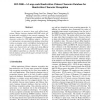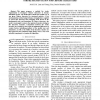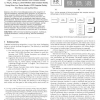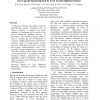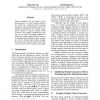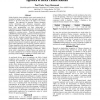143
click to vote
IJDAR
2011
14 years 7 months ago
2011
: A comprehensive online unconstrained Chinese handwriting dataset, SCUT-COUCH2009, is introduced in this paper. As a revision of SCUT-COUCH2008 [1], the SCUT-COUCH2009 database co...
125
click to vote
ICDAR
2009
IEEE
14 years 10 months ago
2009
IEEE
This paper describes a publicly available database, CASIA-OLHWDB1, for research on online handwritten Chinese character recognition. This database is the first of our series of on...
179
click to vote
ICDAR
2009
IEEE
2009
IEEE
HCL2000 - A Large-scale Handwritten Chinese Character Database for Handwritten Character Recognition
14 years 10 months ago
In this paper, we present a large scale off-line handwritten Chinese character database-HCL2000 which will be made public available for the research community. The database contai...
CDC
2009
IEEE
14 years 10 months ago
2009
IEEE
This paper proposes a method for stroke segmentation to decompose Chinese characters to become individual strokes. The method first obtains the medial axes of any given Chinese cha...
116
click to vote
PAMI
1998
15 years 18 days ago
1998
—One of the most challenging topics is the recognition of Chinese handwriting, especially offline recognition. In this paper, an offline recognition system based on multifeature ...
101
click to vote
COMPUTER
2004
15 years 24 days ago
2004
highly abstracted. The Chinese writing system uses logographs--conventional representations of words or morphemes. Characters of the most common kind have two parts, one suggesting...
110
click to vote
COLING
2000
2000
Jurilinguistic Engineering in Cantonese Chinese: An N-gram-based Speech to Text Transcription System
15 years 2 months ago
A Cantonese Chinese transcription system to automatically convert stenograph code to Chinese characters ix reported. The major challenge in developing such a system is the critica...
134
click to vote
DMS
2008
15 years 2 months ago
2008
Inputting written Chinese, unlike written English, is a non-trivial operation using a standard keyboard. To accommodate this operation, numerous existing phonetic systems using th...
ACL
2008
15 years 2 months ago
2008
Chinese characters that are similar in their pronunciations or in their internal structures are useful for computer-assisted language learning and for psycholinguistic studies. Al...
110
click to vote
AAAI
2008
15 years 3 months ago
2008
Unlike English, where unfamiliar words can be queried for its meaning by typing out its letters, the analogous operation in Chinese is far from trivial due to the nature of its wr...

